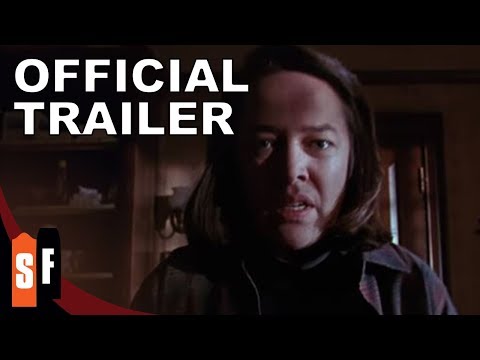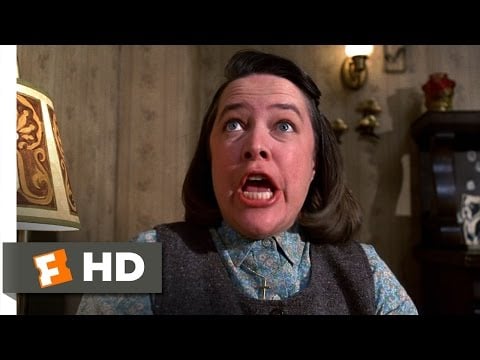Rob Reiner’s “Misery” (1990) has become one of the director’s most well-known and frequently quoted films, which is ironic, as Reiner mostly made comedies up to that point.
“I’m your number one fan.”
Is there anyone alive who doesn’t know the origin of that quote? While many have uttered that phrase, it’s safe to say that few have meant it as much as Annie Wilkes, in declaring her love for Paul Sheldon, her favorite writer and captive.

In Stephen King’s 1987 novel, “Misery,” Wilkes, a reclusive former nurse, is keeping her favorite writer holed up in her cabin. Their relationship turns from devoted fan/guest to brutal punisher/captive, as she forces him to write a blatantly commercial novel…or else. Reiner’s film of King’s “Misery,” adapted by William Goldman for the screen, remains an artistic high point for everyone involved.
Reiner’s sole thriller is his best film, a cleverly constructed seat gripper that was a real surprise coming from him. At this point in his career, Reiner had made “This is Spinal Tap” (1984), “The Sure Thing” (1985), “Stand by Me” (1986), “The Princess Bride” (1987) and “When Harry Met Sally…” (1989), all great films, none of them remotely like the other.
The only connective thread they share is Reiner’s consistent directorial flexibility, in which he was willing to adapt to the demands and tone of the material.
Working with Goldman’s smart, rich screenplay and Barry Sonnenfeld’s versatile, acrobatic cinematography, Reiner manages to set the story mostly in one room, which alternates between appearing either invitingly warm or a dreaded location for a wake.

The cast is another essential reason for the film’s success. James Caan was no one’s first pick for a romance novelist, and the against-type casting works. Caan’s Paul Sheldon is admittedly writing the Misery Chastain novels as an artistic compromise and a means for revenue, not critical acclaim.
Caan’s face conveys the long, sad, sell-out that Sheldon has been enduring and how the creation of his latest, Misery-free novel is a reason to feel alive again.
Kathy Bates was the film’s biggest discovery, as the former stage star and sometime character actress was assigned a role conceived by King as older. From her first moment on camera, Bates is ideal as Annie Wilkes, making the character’s brute strength, folksy demeanor, and pride a thin mask of sanity that is always about to break.
Her outbursts become bigger and scarier as the film progresses, and Bates makes Wilkes a hypnotic tour de force.
I share a film buff’s enthusiasm for “The Shawshank Redemption” (1994), “The Shining” (1980), “The Dead Zone” (1983), “Pet Sematary” (both versions), “The Mist” (2007), “Dolores Claiborne” (1995), “Cat’s Eye” (1985), “The Green Mile’ (1999), “1408” (2007) and Reiner’s “Stand By Me” (1986) but I’d say “Misery” is the best King film. The core reason is that it’s a much better movie than it is a book.
Reiner and Goldman have deleted the aspects of the novel that were, to use King’s terminology, “gooshy.” An absurd murder with a lawn mower and a too-much moment with an axe (replaced, rather artfully, in the film with a sledgehammer) have been altered or are altogether gone.
“Misery” is quite violent at times and the grisly moments are well-earned and expertly staged.
Kathy Bates in Misery (1990) gives a performance so unpredictable it keeps shifting between warmth and pure menace.
pic.twitter.com/GAJnT4FTuA https://t.co/Y3urIxsvDv— cinesthetic. (@TheCinesthetic) August 19, 2025
Reiner has made it more of a psychological chess match than a gory free-for-all that King inched towards. The emphasis on Buster the Sheriff (movingly played by Richard Farnsworth), his wife (the always-wonderful Frances Sternhagen) and Paul’s literary agent (film legend Lauren Bacall) adds a relief from the two-person structure and welcome comic relief. The actors make these figures engaging and real, as opposed to mere supporting character distractions.
“Misery” became a Broadway stage play at the Broadhurst Theater in 2015. Laurie Metcalfe played Wilkes and, as Paul Sheldon, her co-star was no less than Bruce Willis. While the Broadway adaptation was written by Goldman, I was present at the legendary 2008 production, penned by Simon Moore, that took place in the Miner’s Alley Playhouse in Golden, CO.
It was a two-person show starring Paige Larson and Carjado Lindsey (both riveting as Wilkes and Sheldon). The production maintained the original foot-severing scene from King’s novel. It made for a terrifying night of theater that still haunts my wife and me.
“Misery” is a perfect thriller and a rich commentary on how one writes “for a living,” literally and figuratively. It works as a cautionary tale against embracing one’s fandom. It’s also a grisly romantic comedy.
Even the final scene, which could have played as a jokey fade-out, is truly chilling in its implications. When you’re Paul Sheldon (or Stephen King, or Steven Spielberg, or anyone famous), everyone you meet is a potential Annie Wilkes.
The post Is ‘Misery’ the Best Stephen King Adaptation? appeared first on Hollywood in Toto.
from Movies - Hollywood in Toto https://ift.tt/adprMn2

0 Comments: